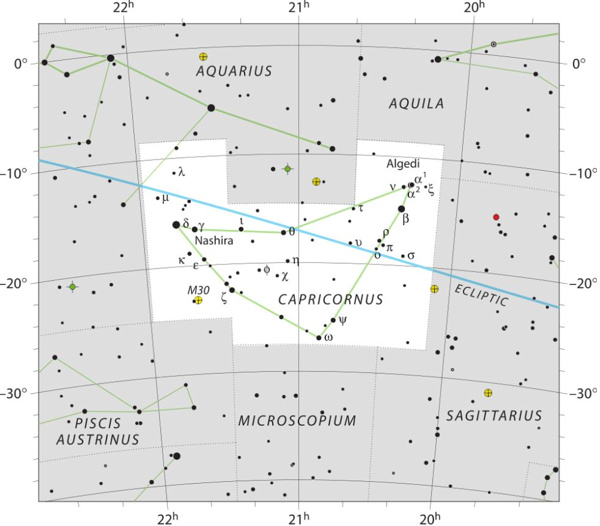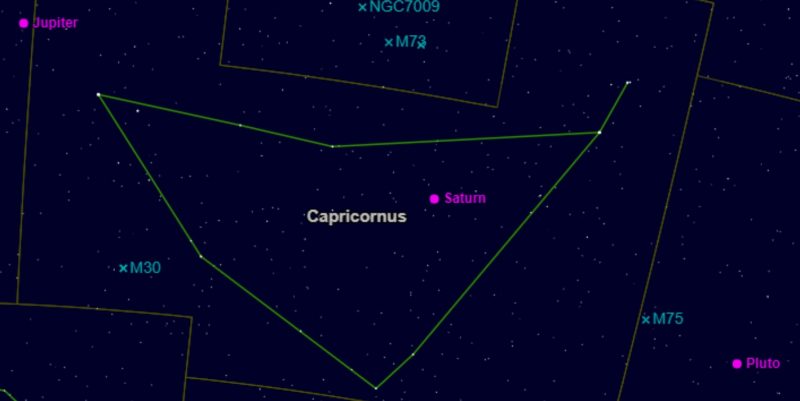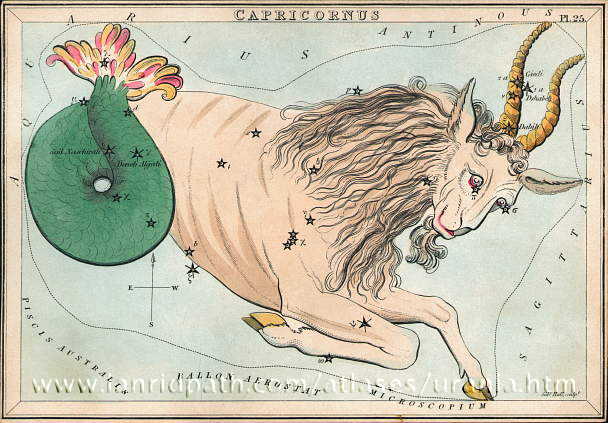
Capricornus looks like an arrowhead
Capricornus the Sea-goat is one of the 12 constellations of the zodiac. The sun passes through it from mid-January to mid-February, every year. For observers in the Northern Hemisphere, the constellation never gets very high above the southern horizon. Your best time to look for the constellation is in late summer or early autumn evenings. The constellation is faint. You will need a dark sky.
Capricornus is more prominent as seen from Earth’s Southern Hemisphere. From there, look northward to overhead to see this constellation. And know that the arrowhead shape will be upside-down, when compared to the charts below.
Capricornus is the smallest zodiac constellation. It contains only one Messier object, called M30. The M-objects easy to see with binoculars or small telescopes. They’re also fascinating to contemplete. M30, for example, is a globular cluster that’s racing toward Earth at 118 miles an hour (182 kph).


Star-hop to find Capricornus
Look for the constellation Capricornus in the early evening in September and October. If you live in the Northern Hemisphere, and are familiar with the Summer Triangle asterism, draw an imaginary line from the star Vega and through Altair to find this arrowhead-shaped constellation low in the southern sky. At mid-northern latitudes, the huge Summer Triangle asterism hangs high in the south to overhead on autumn evenings.
Another way to star-hop to Capricornus from northerly latitudes is by way of the constellation Cygnus the Swan – or as others see it – the Northern Cross asterism. Draw an imaginary line from the bright Summer Triangle star Deneb through the star Epsilon Cygni to locate Capricornus the Sea-goat rather close to the horizon.


Stars and more in Capricornus
In 2021, Saturn is floating through the constellation Capricornus, while Jupiter pops in and out for a visit. Jupiter crossed from Capricornus into Aquarius in April, and will cross back into Capricornus around August 19, before crossing back into Aquarius once again in mid-December.
Capricornus’ brightest star is Delta Capricorni, also known as or Deneb Algedi. Deneb Algedi lies on the far eastern side of the constellation and shines at magnitude 2.8. The star – or rather, four stars that are too close for us to separate in telescopes – lies about 39 light-years from Earth.
The only Messier object in Capricornus is M30, a globular cluster that lies about 28,000 light-years away. At magnitude 5.2, M30 is easy for small telescopes to spy, and binoculars will show it as a hazy patch. M30 has experienced core collapse, meaning that most of the stars and mass in the cluster are packed tightly into the core. M30 goes against the flow of other objects in the Milky Way. This strange movement means that it was probably once a satellite galaxy captured by the Milky Way. The globular cluster is racing toward us at 118 miles an hour (182 kph).
Hickson Compact Group 87 is a cluster of galaxies in Capricornus that is too faint for most amateurs to spot with backyard telescopes but amazing with professional scopes such as the Hubble Space Telescope.

Capricornus or Capricorn?
Capricornus generally refers the constellation while Capricorn identifies the corresponding zodiac sign. In 2021, the sun passes in front of the constellation Capricornus from January 19 to February 16. The zodiacal sign of Capricorn includes people with birthdays from December 22 to January 19. Why the discrepancy?
When astrologers began casting horoscopes thousands of years ago, the sun was in Capricornus during the time frame suggested by astrology today. But because the precession of the equinoxes, the equinox and solstice points move 30o westward in front of the zodiacal constellations – backdrop stars – over a period of about 2,160 years. This is basically a way of saying that the Earth wobbles as it spins. Over time, this wobbles shifts our perspective on the background stars.
The 12 signs of the zodiac existed by around 450 B.C. A few hundred years later, in 131 B.C., the solstice point moved out of the constellation Capricornus and into the constellation Sagittarius. Most systems of astrology have not updated their signs and dates to correspond with the new dates, and the constellations in the real sky. Looking into the future, the December solstice point will cross into the constellation Ophiuchus in the year 2269. These dates are based upon the constellation boundaries as defined by the International Astronomical Union in 1930.
The most important point to remember, when you’re talking about astronomy and the constellation, is that Capricornus is constellation name.

How a sea-goat came to reside among the stars
The image of Capricornus as the Sea-goat is said to have come from Oannes (Adapa), the Sumerian god of wisdom. The ancient Greeks associated Capricornus with their god Pan.
Typhon, the dreadful fire-breathing monster, was about to devour Pan. But Pan turned himself into a fish – or tried to – before jumping into a river to make his great escape. However, Pan was so scared that he goofed up, changing himself into a half-goat, half-fish hodgepodge instead of a fish.
In other words, Pan pan-icked. Thus, the word panic originated from the god Pan’s misadventure with Typhon, the fire-breathing monster.
Bottom line: Capricornus the Sea-goat can be spotted in September and October formed by stars that take the shape of an arrowhead. One Messier object, M30, is found within.
Taurus? Here’s your constellation
Gemini? Here’s your constellation
Cancer? Here’s your constellation
Leo? Here’s your constellation
Virgo? Here’s your constellation
Libra? Here’s your constellation
Scorpius? Here’s your contellation
Sagittarius? Here’s your constellation
Capricornus? Here’s your constellation
Aquarius? Here’s your constellation
Pisces? Here’s your constellation
Aries? Here’s your constellation
Birthday late November to early December? Here’s your constellation
The post Capricornus? Here’s your constellation first appeared on EarthSky.
from EarthSky https://ift.tt/3AWkcJ7

Capricornus looks like an arrowhead
Capricornus the Sea-goat is one of the 12 constellations of the zodiac. The sun passes through it from mid-January to mid-February, every year. For observers in the Northern Hemisphere, the constellation never gets very high above the southern horizon. Your best time to look for the constellation is in late summer or early autumn evenings. The constellation is faint. You will need a dark sky.
Capricornus is more prominent as seen from Earth’s Southern Hemisphere. From there, look northward to overhead to see this constellation. And know that the arrowhead shape will be upside-down, when compared to the charts below.
Capricornus is the smallest zodiac constellation. It contains only one Messier object, called M30. The M-objects easy to see with binoculars or small telescopes. They’re also fascinating to contemplete. M30, for example, is a globular cluster that’s racing toward Earth at 118 miles an hour (182 kph).


Star-hop to find Capricornus
Look for the constellation Capricornus in the early evening in September and October. If you live in the Northern Hemisphere, and are familiar with the Summer Triangle asterism, draw an imaginary line from the star Vega and through Altair to find this arrowhead-shaped constellation low in the southern sky. At mid-northern latitudes, the huge Summer Triangle asterism hangs high in the south to overhead on autumn evenings.
Another way to star-hop to Capricornus from northerly latitudes is by way of the constellation Cygnus the Swan – or as others see it – the Northern Cross asterism. Draw an imaginary line from the bright Summer Triangle star Deneb through the star Epsilon Cygni to locate Capricornus the Sea-goat rather close to the horizon.


Stars and more in Capricornus
In 2021, Saturn is floating through the constellation Capricornus, while Jupiter pops in and out for a visit. Jupiter crossed from Capricornus into Aquarius in April, and will cross back into Capricornus around August 19, before crossing back into Aquarius once again in mid-December.
Capricornus’ brightest star is Delta Capricorni, also known as or Deneb Algedi. Deneb Algedi lies on the far eastern side of the constellation and shines at magnitude 2.8. The star – or rather, four stars that are too close for us to separate in telescopes – lies about 39 light-years from Earth.
The only Messier object in Capricornus is M30, a globular cluster that lies about 28,000 light-years away. At magnitude 5.2, M30 is easy for small telescopes to spy, and binoculars will show it as a hazy patch. M30 has experienced core collapse, meaning that most of the stars and mass in the cluster are packed tightly into the core. M30 goes against the flow of other objects in the Milky Way. This strange movement means that it was probably once a satellite galaxy captured by the Milky Way. The globular cluster is racing toward us at 118 miles an hour (182 kph).
Hickson Compact Group 87 is a cluster of galaxies in Capricornus that is too faint for most amateurs to spot with backyard telescopes but amazing with professional scopes such as the Hubble Space Telescope.

Capricornus or Capricorn?
Capricornus generally refers the constellation while Capricorn identifies the corresponding zodiac sign. In 2021, the sun passes in front of the constellation Capricornus from January 19 to February 16. The zodiacal sign of Capricorn includes people with birthdays from December 22 to January 19. Why the discrepancy?
When astrologers began casting horoscopes thousands of years ago, the sun was in Capricornus during the time frame suggested by astrology today. But because the precession of the equinoxes, the equinox and solstice points move 30o westward in front of the zodiacal constellations – backdrop stars – over a period of about 2,160 years. This is basically a way of saying that the Earth wobbles as it spins. Over time, this wobbles shifts our perspective on the background stars.
The 12 signs of the zodiac existed by around 450 B.C. A few hundred years later, in 131 B.C., the solstice point moved out of the constellation Capricornus and into the constellation Sagittarius. Most systems of astrology have not updated their signs and dates to correspond with the new dates, and the constellations in the real sky. Looking into the future, the December solstice point will cross into the constellation Ophiuchus in the year 2269. These dates are based upon the constellation boundaries as defined by the International Astronomical Union in 1930.
The most important point to remember, when you’re talking about astronomy and the constellation, is that Capricornus is constellation name.

How a sea-goat came to reside among the stars
The image of Capricornus as the Sea-goat is said to have come from Oannes (Adapa), the Sumerian god of wisdom. The ancient Greeks associated Capricornus with their god Pan.
Typhon, the dreadful fire-breathing monster, was about to devour Pan. But Pan turned himself into a fish – or tried to – before jumping into a river to make his great escape. However, Pan was so scared that he goofed up, changing himself into a half-goat, half-fish hodgepodge instead of a fish.
In other words, Pan pan-icked. Thus, the word panic originated from the god Pan’s misadventure with Typhon, the fire-breathing monster.
Bottom line: Capricornus the Sea-goat can be spotted in September and October formed by stars that take the shape of an arrowhead. One Messier object, M30, is found within.
Taurus? Here’s your constellation
Gemini? Here’s your constellation
Cancer? Here’s your constellation
Leo? Here’s your constellation
Virgo? Here’s your constellation
Libra? Here’s your constellation
Scorpius? Here’s your contellation
Sagittarius? Here’s your constellation
Capricornus? Here’s your constellation
Aquarius? Here’s your constellation
Pisces? Here’s your constellation
Aries? Here’s your constellation
Birthday late November to early December? Here’s your constellation
The post Capricornus? Here’s your constellation first appeared on EarthSky.
from EarthSky https://ift.tt/3AWkcJ7

Aucun commentaire:
Enregistrer un commentaire